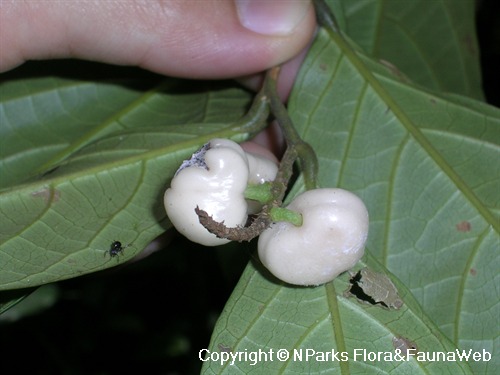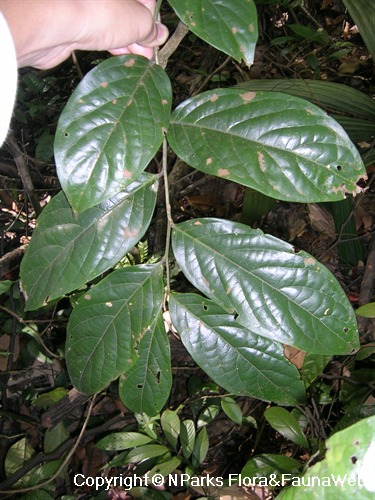
Back
Galearia fulva (Tul.) Miq.
| Family Name: | Pandaceae |
| Synonyms: | Galearia affinis (R.Br.) Miq., Galearia finlaysonii (R.Br.) Miq., Galearia fusca Ridl., Galearia lindleyana (Tul.) Hook.f., Galearia minor Gage, Galearia pedicellata (R.Br.) Miq., Galearia phlebocarpa (R.Br.), Galearia ridleyi Gage, Galearia subulata (Müll.Arg.) Hook.f., Galearia wallichii (R.Br.) Kurz |
Name
Classifications and Characteristics
| Plant Division | Angiosperms (Flowering Seed Plants) (Dicotyledon) |
|---|---|
| Plant Growth Form | Tree, Shrub |
| Lifespan (in Singapore) | Perennial |
| Mode of Nutrition | Autotrophic |
| Plant Shape | Irregular |
Biogeography
| Native Distribution | Myanmar, Peninsular Malaysia, and Singapore |
|---|---|
| Native Habitat | Terrestrial (Primary Rainforest, Secondary Rainforest, Freshwater Swamp Forest) |
| Preferred Climate Zone | Tropical |
| Local Conservation Status | Native to Singapore (Vulnerable (VU)) |
Description and Ethnobotany
| Growth Form | It is a shrub or a tree. |
|---|---|
| Foliage | Its stalked leaves have blades that are elliptic-lance-shaped and hairless except on the midrib of both surfaces. |
| Flowers | Its flower clusters have no or short bracts. |
| Fruit | Its young fruit is oblong, 2-chambered, angular, and up to 7 by 5 mm. |
| Habitat | It grows in forests. It occurs locally in Nee Soon Swamp Forest, Mandai, Bukit Timah Nature Reserve, Central Catchment Nature Reserve, and in the vicinities of Upper Peirce and MacRitchie Reservoirs. |
| Cultivation | It can be propagated by seed. |
| Etymology | Latin Galearia, helmeted, referring to the concave petals; Latin fulvus, slightly tawny |
Landscaping Features
| Landscaping | It is suitable for parks. |
|---|---|
| Landscape Uses | Parks & Gardens |
Fauna, Pollination and Dispersal
| Pollination Method(s) | Biotic (Fauna) |
|---|---|
| Seed or Spore Dispersal | Biotic (Fauna) |
Plant Care and Propagation
| Light Preference | Semi-Shade |
|---|---|
| Water Preference | Moderate Water |
| Plant Growth Rate | Moderate |
| Rootzone Tolerance | Moist Soils, Well-Drained Soils, Fertile Loamy Soils |
| Propagation Method | Seed |
Foliar
| Foliage Retention | Evergreen |
|---|---|
| Mature Foliage Colour(s) | Green |
| Mature Foliage Texture(s) | Leathery |
| Foliar Type | Simple / Unifoliate |
| Foliar Arrangement Along Stem | Alternate |
| Foliar Attachment to Stem | Petiolate |
| Foliar Shape(s) | Non-Palm Foliage (Lanceolate, Elliptical) |
| Foliar Venation | Pinnate / Net |
| Foliar Margin | Entire |
| Leaf Area Index (LAI) for Green Plot Ratio | 3.0 (Tree - Intermediate Canopy) |
Floral (Angiosperm)
| Flower & Plant Sexuality | Bisexual Flowers |
| Flower Grouping | Cluster / Inflorescence |
|---|---|
| Flower Location | Axillary |
Fruit, Seed and Spore
| Mature Fruit Colour(s) | White |
|---|---|
| Fruit Classification | Simple Fruit |
Image Repository
Others
| Master ID | 1629 |
|---|---|
| Species ID | 2922 |
| Flora Disclaimer | The information in this website has been compiled from reliable sources, such as reference works on medicinal plants. It is not a substitute for medical advice or treatment and NParks does not purport to provide any medical advice. Readers should always consult his/her physician before using or consuming a plant for medicinal purposes. |


.jpg)